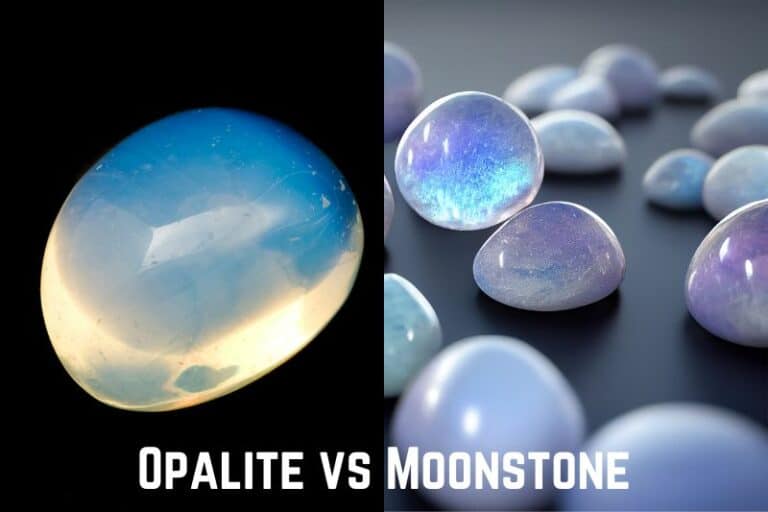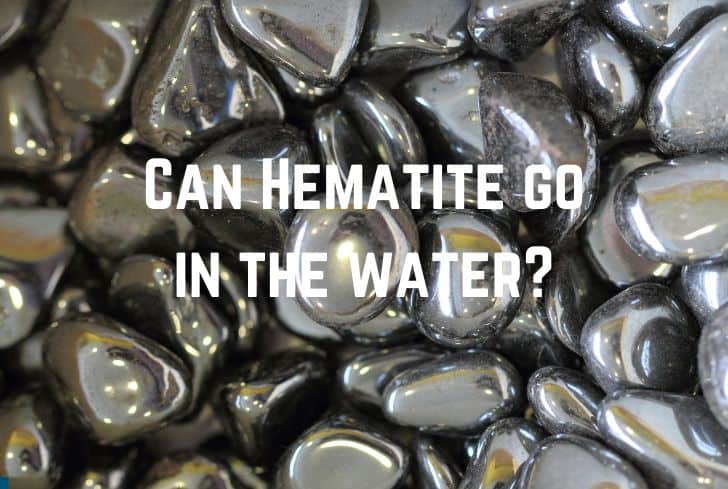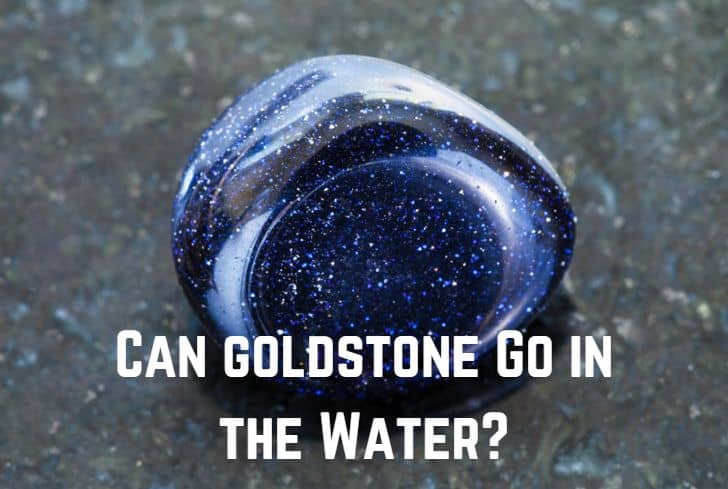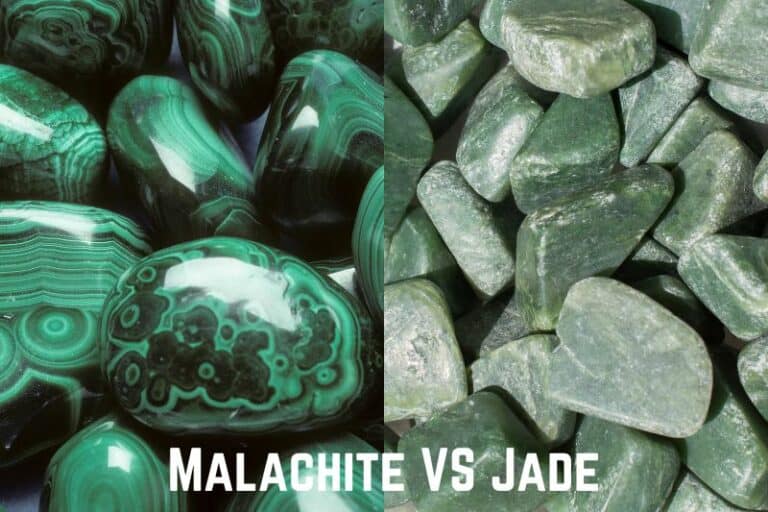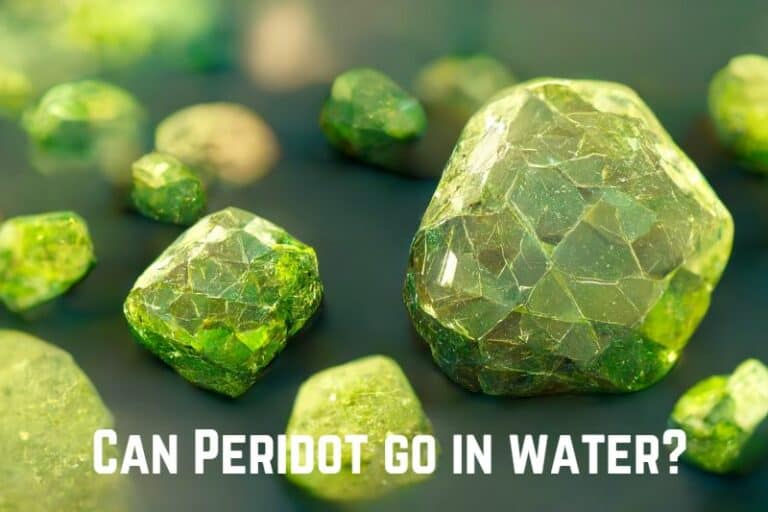Can Larimar Go in the Water? (And Salt Water?)
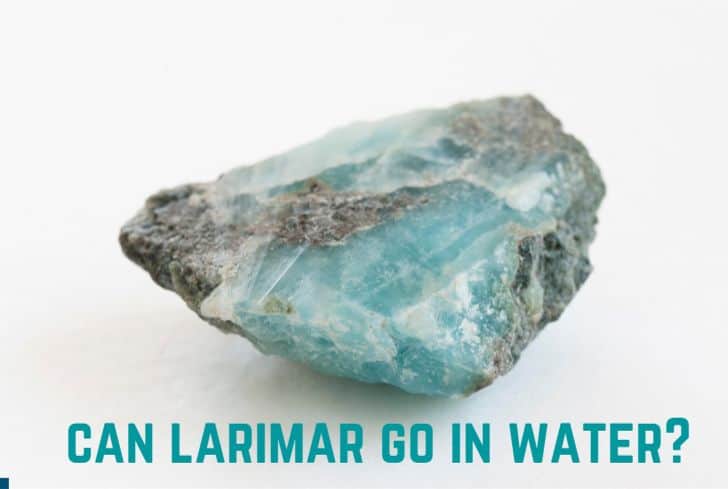
Larimar is the tradename of a rare blue variety of pectolite. It is an inosilicate mineral having the chemical formula NaCa2Si3O8(OH). The stone gets its name from one of its discoverers, Miguel Méndez. Mendez found the stone on a beach, so he took his daughter’s name “Larissa” and joined it with the Spanish word for sea (“mar”), making “Larimar”.
Have you ever wondered if Larimar can go in the water? In this article, we are going to discuss just that. We will begin by looking at the properties of Larimar. Then we will talk about its interaction with water, sunlight, and salt. Finally, we will learn how to clean larimar.
Read: Can Shungite Go in the Water?
Can Larimar Crystal go in the Water?
Yes, larimar can go in the water. It has a value of 4.5 to 6 on the Mohs Hardness Scale, which is right around the minimum value required for minerals to be safe underwater. However, like all stones, it should not be immersed for too long as water can damage the structure and tarnish the appearance of the stone.
Mohs Hardness Scale is a measure of the relative resistance of a mineral to scratching. Besides that, it also indicates a mineral’s relationship with water. Usually a value above 5.0 means that the mineral is safe to go in water.
Softer stones like selenite (value of 2.0 on the Mohs Scale) should never be immersed in water. But even relatively harder stones like larimar should not be immersed for too long. Water enters the crevices of the stones and expands their cracks. These fissures may not be visible at first but can slowly damage the structure of the stone.
Water can also tarnish the appearance of the crystal. It strips off the polish from the surface, making the stone look duller. Water also encourages fissures, which can change the way light bounces inside the stone, thus damaging the stone’s optical effects.
Properties of Larimar
These are the properties of larimar:
- Appearance: Larimar is a rare blue variety of pectolite, and it can come in a large range of colourations: bluish-white, green-blue, turquoise blue-green, dark blue, violet, etc. The blue colour of larimar is the result of copper substituting sodium in pectolite. In terms of diaphaneity, it ranges from translucent to transparent. The stone has a subvitreous or silky lustre.
- Structure: Larimar belongs to the triclinic crystal system. Its crystals occur in different forms: tabular, acicular (needle-shaped), radiating fibrous, columnar, or spheroidal. It has perfect cleavage and an uneven fracture. The crystals also exhibit twinning with the composition plane [100].
- Hardness: Larimar has a value of 4.5-5 on the Mohs Hardness Scale. This means that it is a relatively soft mineral that can easily get scratched. It should also not be left in water for long. Besides its softness, larimar also has low tenacity, meaning that it is brittle and can get damaged upon impact.
- Formation: Larimar is found in the Dominican Republic, where volcanic rocks, basalts, and andesites erupted within the limestones of the island. The cavities of these rocks were later filled with various minerals, including blue pectolite. When the rocks erode, the pectolite fillings are carried down to the alluvium and beach gravels. The tumbling of the stones on the streambed provides a natural polish to larimar.
- Optical Properties: The fibrous material of larimar has chatoyancy that can give a cat’s eye effect to the stone. It refers to the optical effect in which a band/line of light is reflected by the surface of cabochon-cut gemstones. This creates an appearance similar to light bouncing off a cat’s eye. It is caused by a series of thin inclusions that are parallel to each other.
Besides these physical properties, larimar is also believed to have several spiritual properties. It is said to represent peace and clarity. Its radiating healing energy and love energy make it ideal for people who are stressed as it works as a healing stone for them.
Larimar stimulates the heart, throat, third eye and crown chakra. Check out this video by Shannon Marie to learn more about the spiritual properties of the stone.
Can Larimar Go in Salt Water?
No, larimar should not be put in salt water. With a value of 4.5 to 6 on the Mohs Hardness Scale, larimar is just barely safe to go in water. Over longer periods, even water can be damaging to the structure and appearance of the stone. When we bring salt into the mix, it makes the corrosive effect worse.
Salt, when dissolved in water, is able to enter the crevices of the stone. The salt particles remain there even after the water evaporates and they expand the cracks. These fissures can slowly damage the structure of the stone, making it brittle.
Salt can also react adversely with the elements of the stone, especially those containing iron. Salt water hastens the rusting process by making the iron lose its electrons more easily.
Can Larimar Go in the Sun?
No, larimar should not go in the sun. Although keeping stones out in sunlight is a popular way of recharging them, it is not recommended for all stones. Larimar is a rare blue variety of pectolite, and its beautiful colour is photosensitive. This can fade away due to sunlight.
Using sunlight is a common way of recharging stones, but one should always check the properties of the stone before doing so. Larimar’s blue colour is photosensitive, and when exposed to excessive heat or light for a long time, it can fade away.
This is why it’s not recommended to put larimar out in sunlight. Instead, you can try other recharging methods like moonlight or sage.
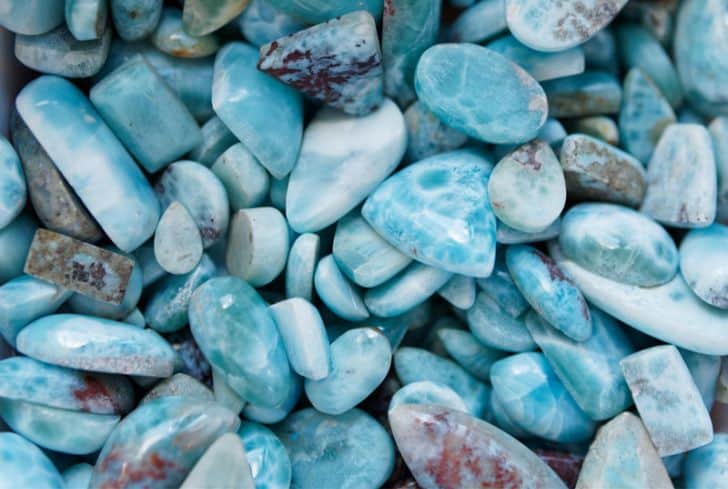
Can You Shower With Larimar?
Larimar is safe underwater for short periods, but it is not really recommended to wear its jewelry while showering. This is because larimar is a relatively soft and brittle stone, which should not unnecessarily been exposed to water. Moreover, showering can make the stone prone to other damages too.
Larimar has a value of 4.5 to 6 on the Mohs Hardness Scale, so it is a relatively soft stone. While it can be cleaned using soap water, it is better not to expose such stones to water unnecessarily.
Moreover, softer and brittle stones like these are prone to get scratched or fractured easily. For example, in the shower, they can slip on the floor and the impact can severely damage them. Therefore, it’s always best to take off such soft gems when engaged in activities like exercising, showering, cleaning, etc.
Read: Can Red Jasper Go in the Water?
Is Larimar a Rare Stone?
Yes. Although pectolite is found in many locations of the world, larimar is a rare stone that comes only from around Barahona city in the Dominic Republic. Though the stone is locally abundant in the Caribbean, it is a rare gem material for the world at large.
Pectolite is a white-to-grey mineral that is a sodium calcium hydroxide silicate. It occurs as a primary mineral in nepheline syenites, serpentinites, and within hydrothermal cavities in diabase and basalts.
Although pectolite is found all over the world, larimar is a rare blue variant found only in the Dominican Republic. Its blue colour comes from the substitution of copper for calcium. The stone was discovered in 1974 on the beach of the Bahoruco Mountain Range.
The few stones found were alluvial sediment, washed down by the Bahoruco River, and the searchers went upstream to find the Los Chupaderos, which is now the most important deposit of larimar.
How to Clean and Take Care of Larimar?
Follow these steps to clean larimar:
- Mix a soft detergent/soap with warm water.
- Immerse larimar in the solution for a few minutes and clean it with a soft brush.
- Rinse the stone under running water to get rid of all the excess soap.
- Let it air dry. Make sure you twist the stone a few times to remove all water from the crevices.
Larimar can survive underwater, so this method is safe for cleaning it. However, the stone has a very low hardness, having a value of 4.5 to 6 on the Mohs Hardness Scale. This means that the stone can easily get scratched and even other stones like quartz and topaz can scratch them.
Store your larimar separately from other gemstones. Soft stones like larimar should only be used for jewellery that is less prone to impact like earrings and pendants. However, when used in rings, use protecting settings with larimar.
Do not use steam cleaners for larimar because its blue colour is photosensitive. It fades with time when exposed to excessive heat or light.
Read: Can Apatite Go in the Water?
Conclusion
In this article, we have discussed larimar’s interaction with water. With a value of 4.5 to 6 on the Mohs Hardness Scale, larimar is quite a soft mineral but it can safely go in the water for a short period. We looked at the properties of larimar, and why its occurrence only in the Dominican Republic make it a rare gem. Finally, we also learnt how to clean and take care of the stone.

